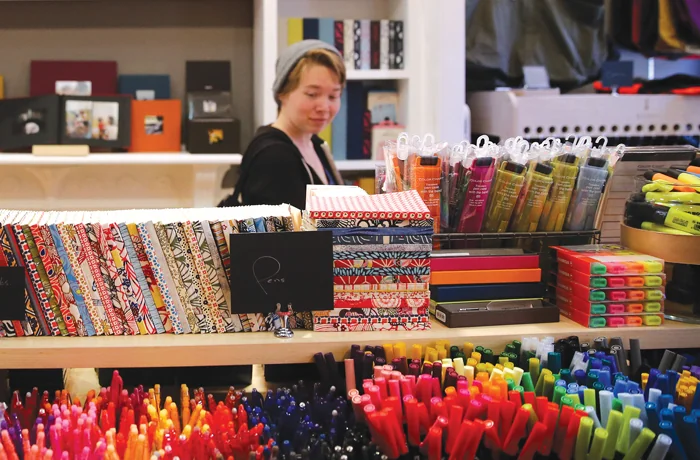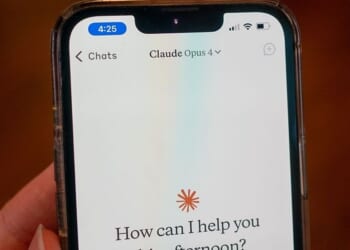Itoya, a store entirely dedicated to the craft of writing by hand, comprises 12 sunlit stories of retail space in the heart of Tokyo’s Ginza shopping district. It sells fountain pens, boutique colored pencils, and ink markers in a rainbow of colors for writing on a thousand varieties of paper ranging from simple Post-Its to imperially bespoke linen. It’s not the sort of thing you’d expect to draw a capacity crowd in 2025. Haven’t we all gone digital? Don’t we take notes on our phones and do our correspondence via keyboard?
Apparently not. Itoya is packed tight with chattering schoolgirls and serious-looking men in the weekend dress-up garb long abandoned on American shores: leather-soled shoes, Loro Piana sweaters. There’s a line to get through the front door, manned by apologetic attendants and moving at the rate of a few people per minute. The ground level is filled with scattershot five-dollar trinkets, with prices rising into the four and five figures as you ride successive escalators to a top-floor cafe.
The consumer interest in well-crafted handwriting tools on display at Itoya is not merely a Japanese cultural phenomenon but one that bespeaks a worldwide turn, or return, to old-fashioned pen and ink. Itoya, operating as “Topdrawer,” is now in New York, San Francisco, and elsewhere. There’s been an explosion of online shops specializing in everything from Japanese rollerballs (Jetpens.com) to lathe-turned stainless-steel fountain pens made one at a time in Pennsylvania (Birminghampens.com). Second-hand prices on eBay and elsewhere are on the rise for everything from vintage acetate Pelikans to the chrome-and-gold Cross ballpoints once omnipresent in American corporate offices.

This could all be dismissed as dopamine-fueled purchase-hobbying, such as Funko Pops or Beanie Babies, but there has also been a nontrivial jump in online handwriting instruction, personal handwriting tutors, and even brand-new penmanship books that purport to rectify in adults what the Palmer Method was supposed to codify in children. As early as 10 years ago, Harvard Business Review recommended moving to handwritten notes for important corporate communications. That same advice is now percolating across thousands of LinkedIn pages.
In other words, a modest but very real resurgence is happening out there, both in the market for expensive pens and in the perceived importance of communicating through actual writing rather than via impersonal, spam-surrounded, electronic messages. And as with mechanical wristwatches and manual transmissions, a bit of snobbery and prestige has become attached to something that used to be an everyday part of American life before digitalization rendered it allegedly obsolete.
The reasons for this are fairly obvious. The old accoutrements of luxury, such as air travel and designer labels, have been commoditized to a fare-thee-well. Every car has power windows, every television is 5 feet across, and every apartment has solid surface counters. So our middle and upper classes increasingly see time and personal attention as the only true luxuries left. This is why personal fitness is so prized by today’s rich people, incidentally; it’s an explicit demonstration of immense free time to exercise and cook healthy meals.
A handwritten note is, then, a powerful demonstration of status. It shows that you have the time, education, and materials necessary to sit down and compose a readable communication. It’s also a direct compliment to the person receiving it: I think so much of you that I’ll dip a fountain pen, find my stationery, and lick a stamp. For the so-called “laptop class”, writing by hand indicates a certain privilege: One may uncouple the electronic leashes and compose one’s thoughts at leisure, away from the glow of iPhone or MacBook. In a world where many of us are expected to be reachable 24/7, quiet moments with pen in hand represent real freedom. Think of the scene in George Orwell’s 1984 where O’Brien switches off the telescreen.
A handwritten note cannot be copied and pasted from its predecessor with a mere Ctrl+C and Ctrl+V. It cannot be sent to multiple recipients at once. It cannot be the work of a single impulsive moment. (However, in 18th-century London, where the mail came twice a day or more and gentlemen would often dash off angry or confrontational notes while the “post-boy” waited, such was not the case.)
Most importantly, to receive a handwritten note is to be the subject of someone’s undivided attention, however briefly. For generations that have grown up attending concerts, dinners, and art shows where everyone is distracted by their phones, it’s almost indecently personal. And while one could conceivably write a letter by asking ChatGPT to do it and then copying the response onto paper, even that would represent an investment of time and effort beyond what most are willing to do.
Would-be correspondents-by-post can take additional solace in the fact that the standards for letter-writing have been relaxed considerably since the days of Lord Chesterfield and Samuel Johnson, or even since Henry Miller and Anaïs Nin. A single sheet will suffice in most instances, three at most. We’re all busy nowadays, and most of us have lost the knack of reading cursive or even block print in a hurry. But we have also lost the knack of not being in a hurry to do even trivial things. The resurgent market for beautiful, physical things with which to write is evidence that the loss is one we feel sorely.
Your humble author was both early and eager to abandon handwritten letters; having broken my hands several times as a professional cyclist, I have always found it painful to write. As early as 1989, I was doing much of my correspondence via email, and by the turn of the century, I was typing and printing any letter that couldn’t be sent electronically. Yet, I’ve found some real joy over the past few years in once again doing it the old-fashioned way.
For one thing, modern fountain pens are deeply seductive devices. The best of them cost Rolex money and glide along good paper like fingertips on velvet, but even a $29 Lamy Safari is satisfying to use. In between, there are unique devices such as the Kaweco Liliput Fireblue, a diminutive raw steel pen made in Germany, finished by applying a torch to the metal until a unique heat pattern appears. And the inks! Lately I’ve been partial to the small-batch “Quantum Teal” by the aforementioned Birmingham Pen Co., but I also enjoy “Lierre Sauvage” by J. Herbin and the time-tested, but unimaginatively yclept, Pelikan 4001, which produces a deep royal blue on the page. In exceptional circumstances, I’ll use Diamine’s “Shimmering Seas”, which has flecks of gold in an oceanic indigo base. None of these will run you more than $40 a bottle, which will be trivial to some epistolarians and shocking to others.
The secret to a good letter, however, is in the stationery, which is to penmanship what tires are to a sports car: merely the most important part. Itoya has an unimpeachable selection of Japanese paper, but patriots will want to look at Crane, which has been operating in the United States through various ownership since 1801. Another option, suitable for men and women of action: order the larger “Field Notes” notebooks and simply rip the pages out as you use them.
The best part of writing letters by hand ultimately has nothing to do with the details of pen and ink. Rather, it is permanence, or the prevention of the same. Most of us do not really own our email. It can be deleted anytime, possibly without our knowledge or consent. And we cannot keep it from being read by governments, tech companies, advertising partners, and various artificial intelligence plagiarism machines. Such is not true of an actual letter, which can be stored for posterity if desired or consigned to the flames should it suit.
WHY USED-CAR SHOPPERS CAN IGNORE ODOMETERS
As you’d expect, there are services on the internet that will produce auto-penned letters on your behalf, but these, like the “handwritten” notes from car dealerships and cable providers, are far more obviously fraudulent via pen and ink than they are in one’s electronic inbox. There’s something essentially human about the act of writing. It’s why our ancestors scrawled on cave walls, it’s why we all distrust emails and even printed letters just a little bit, and it’s why Itoya Ginza has a line of people waiting to get inside on an average Thursday.
Is the pen mightier than the sword? That’s up for debate. Is it more personal, more decent, more human than the email? That is a certainty.
Jack Baruth was born in Brooklyn, New York, and lives in Ohio. He is a pro-am race car driver and a former columnist for Road and Track and Hagerty magazines who writes the Avoidable Contact Forever newsletter.















